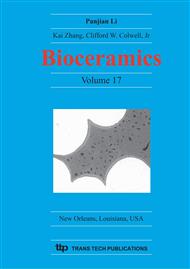p.577
p.581
p.585
p.589
p.593
p.597
p.603
p.607
p.611
Genotoxicity Effects of Ceramic Coatings Applied on Metallic Substrates Using Single Cell Gel Electrophoresis Assay In Vitro
Abstract:
Sol-Gel coatings are a good choice for protection and bioactivation of metals used as dentistry and standard surgical implant materials. These films should both prevent degradation of the substrates by wear or corrosion, and bioactivate the material for inducing the formation of a hydroxyapatite (HA) rich layer onto the material surface, thereby permitting a natural bonding to living tissues. The aim of this work was to estimate the clastogenicity in vitro by Single Cell Gel lectrophoresis Assay (SCGE) or “comet” assay of coatings of TiN applied by magnetron sputtering and of hybrid layers obtained by Sol-Gel containing glass, glass-ceramic and HA particles on stainless steel AISI 304. Six test specimens were prepared: AISI 304 Stainless Steel coated with an hybrid silica single film (SF), applied by sol-gel process, AISI 304 SS coated with double film with bioactive glass (DFG), glass-ceramics (DFGC) and HA (DFHA) particles, AISI 304 SS coated with TiN multi films (MFTiN) applied by PVD and bare AISI 304 SS (304SS). Significantly lower DNA migration (p>0.005) was observed in the cells of the cultures corresponding to the samples coated with SF, DFG, DFGC, DFHA and MFTiN respect to the bare 304 SS. The comparison between negative control and the same coated samples did not reveal any statistically significant difference (p>0.005) in clastogenicity in vitro evaluated by SCGE.
Info:
Periodical:
Pages:
593-596
Citation:
Online since:
April 2005
Keywords:
Price:
Сopyright:
© 2005 Trans Tech Publications Ltd. All Rights Reserved
Share:
Citation:


